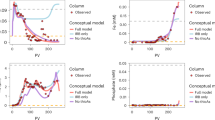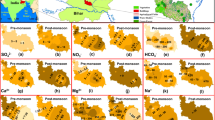Abstract
The origin of dissolved arsenic in the Ganges Delta has puzzled researchers ever since the report of widespread arsenic poisoning two decades ago. Today, microbially mediated oxidation of organic carbon is thought to drive the geochemical transformations that release arsenic from sediments, but the source of the organic carbon that fuels these processes remains controversial. At a typical site in Bangladesh, where groundwater-irrigated rice fields and constructed ponds are the main sources of groundwater recharge, we combine hydrologic and biogeochemical analyses to trace the origin of contaminated groundwater. Incubation experiments indicate that recharge from ponds contains biologically degradable organic carbon, whereas recharge from rice fields contains mainly recalcitrant organic carbon. Chemical and isotopic indicators as well as groundwater simulations suggest that recharge from ponds carries this degradable organic carbon into the shallow aquifer, and that groundwater flow, drawn by irrigation pumping, transports pond water to the depth where dissolved arsenic concentrations are greatest. Results also indicate that arsenic concentrations are low in groundwater originating from rice fields. Furthermore, solute composition in arsenic-contaminated water is consistent with that predicted using geochemical models of pond-water–aquifer-sediment interactions. We therefore suggest that the construction of ponds has influenced aquifer biogeochemistry, and that patterns of arsenic contamination in the shallow aquifer result from variations in the source of water, and the complex three-dimensional patterns of groundwater flow.
This is a preview of subscription content, access via your institution
Access options
Subscribe to this journal
Receive 12 print issues and online access
$259.00 per year
only $21.58 per issue
Buy this article
- Purchase on Springer Link
- Instant access to full article PDF
Prices may be subject to local taxes which are calculated during checkout





Similar content being viewed by others
References
BGS, DFID, DPHE. Arsenic contamination of groundwater in Bangladesh. BGS Technical Report WC/00/19 Vol. 1 & 2 (eds Kinniburgh, D. G. and Smedley P. L.) (British Geological Survey, 2001).
Harvey, C. F. et al. Arsenic mobility and groundwater extraction in Bangladesh. Science 298, 1602–1606 (2002).
Stollenwerk, K. G. et al. Arsenic attenuation by oxidized aquifer sediments in Bangladesh. Sci. Total Environ. 379, 133–150 (2007).
Dowling, C. B., Poreda, R. J., Basu, A. R., Peters, S. L. & Aggarwal, P. K. Geochemical study of arsenic release mechanisms in the Bengal Basin groundwater. Wat. Resourc. Res. 38, 1173 (2002).
Swartz, C. H. et al. Mobility of arsenic in a Bangladesh aquifer: Inferences from geochemical profiles, leaching data, and mineralogical characterization. Geochim. Cosmochim. Acta 68, 4539–4557 (2004).
Zheng, Y. et al. Geochemical and hydrogeological contrasts between shallow and deeper aquifers in two villages of Araihazar, Bangladesh: Implications for deeper aquifers as drinking water sources. Geochim. Cosmochim. Acta 69, 5203–5218 (2005).
Harvey, C. F. et al. Groundwater dynamics and arsenic contamination in Bangladesh. Chem. Geol. 228, 112–136 (2006).
Anawar, H. M. et al. Geochemical occurrence of arsenic in groundwater of Bangladesh: Sources and mobilization processes. J. Geochem. Explor. 77, 109–131 (2003).
Mitamura, M. et al. Geological structure of an arsenic-contaminated aquifer at Sonargaon, Bangladesh. J. Geol. 116, 288–302 (2008).
Van Geen, A. et al. Spatial variability of arsenic in 6000 tube wells in a 25 km(2) area of Bangladesh. Wat. Resourc. Res. 39, 1140 (2003).
Klump, S. et al. Groundwater dynamics and arsenic mobilization in Bangladesh assessed using noble gases and tritium. Environ. Sci. Technol. 40, 243–250 (2006).
Benner, S. G. et al. Groundwater flow in an arsenic-contaminated aquifer, Mekong Delta, Cambodia. Appl. Geochem. 23, 3072–3087 (2008).
Polizzotto, M. L., Kocar, B. D., Benner, S. G., Sampson, M. & Fendorf, S. Near-surface wetland sediments as a source of arsenic release to ground water in Asia. Nature 454, 505–508 (2008).
Welch, P. S. Limnology (McGraw-Hill, 1952).
Sengupta, S. et al. Do ponds cause arsenic-pollution of groundwater in the Bengal basin? An answer from West Bengal. Environ. Sci. Technol. 42, 5156–5164 (2008).
Servais, P., Billen, G. & Hascoet, M. C. Determination of the biodegradable fraction of dissolved organic matter in waters. Water Res. 21, 445–450 (1987).
Neumann, R. B. et al. The hydrology of a groundwater-irrigated rice field in Bangladesh: Seasonal and daily mechanisms of infiltration. Wat. Resourc. Res. 45, W09412 (2009).
Jardine, P. M., McCarthy, J. F. & Weber, N. L. Mechanisms of dissolved organic carbon adsorption on soil. Soil Sci. Soc. Am. J. 53, 1378–1385 (1989).
Kirk, G. The Biogeochemistry of Submerged Soils (Wiley, 2004).
Panaullah, G. et al. Arsenic toxicity to rice (Oryza sativa L.) in Bangladesh. Plant Soil. 317, 31–39 (2009).
Dittmar, J. et al. Spatial distribution and temporal variability of arsenic in irrigated rice field in Bangladesh: 2. Paddy soil. Environ. Sci. Technol. 41, 5967–5972 (2007).
Akai, J. et al. Mineralogical and geomicrobiological investigations on groundwater arsenic enrichment in Bangladesh. Appl. Geochem. 19, 215–230 (2004).
Islam, F. S. et al. Role of metal-reducing bacteria in arsenic release from Bengal delta sediments. Nature 430, 68–71 (2004).
Radloff, K. A. et al. Mobilization of arsenic during one-year incubations of grey aquifer sands from Araihazar, Bangladesh. Environ. Sci. Technol. 41, 3639–3645 (2007).
Van Geen, A. et al. Decoupling of As and Fe release to Bangladesh groundwater under reducing conditions. Part II: Evidence from sediment incubations. Geochim. Cosmochim. Acta 68, 3475–3486 (2004).
Polizzotto, M. L. et al. Solid-phases and desorption processes of arsenic within Bangladesh sediments. Chem. Geol. 228, 97–111 (2006).
Coker, V. S. et al. XAS and XMCD evidence for species-dependent partitioning of arsenic during microbial reduction of ferrihydrite to magnetite. Environ. Sci. Technol. 40, 7745–7750 (2006).
Kocar, B. D., Herbel, M. J., Tufano, K. J. & Fendorf, S. Contrasting effects of dissimilatory iron(III) and arsenic(V) reduction on arsenic retention and transport. Environ. Sci. Technol. 40, 6715–6721 (2006).
Tufano, K. J. & Fendorf, S. Confounding impacts of iron reduction on arsenic retention. Environ. Sci. Technol. 42, 4777–4783 (2008).
Mailloux, B. J. et al. Microbial mineral weathering for nutrient acquisition releases arsenic. Appl. Environ. Microbiol. 75, 2558–2565 (2009).
Welch, S. A., Taunton, A. E. & Banfield, J. F. Effect of microorganisms and microbial metabolites on apatite dissolution. Geomicrobiol. J. 19, 343–367 (2002).
Seddique, A. A. et al. Arsenic release from biotite into a Holocene groundwater aquifer in Bangladesh. Appl. Geochem. 23, 2236–2248 (2008).
Itai, T. et al. Hydrological and geochemical constraints on the mechanism of formation of arsenic contaminated groundwater in Sonargaon, Bangladesh. Appl. Geochem. 23, 2236–2248 (2008).
Smedley, P. L. & Kinniburgh, D. G. A review of the source, behaviour and distribution of arsenic in natural waters. Appl. Geochem. 17, 517–568 (2002).
Clark, I. D. & Fritz, P. Environmental Isotopes in Hydrogeology (Lewis, 1997).
Kaiser, K. & Zech, W. Rates of dissolved organic matter release and sorption in forest soils. Soil Sci. 163, 714–725 (1998).
Orphan, V. J., House, C. H., Hinrichs, K. U., McKeegan, K. D. & DeLong, E. F. Multiple archaeal groups mediate methane oxidation in anoxic cold seep sediments. Proc. Natl Acad. Sci. USA 99, 7663–7668 (2002).
Raghoebarsing, A. A. et al. A microbial consortium couples anaerobic methane oxidation to denitrification. Nature 440, 918–921 (2006).
Stute, M. et al. Hydrological control of As concentrations in Bangladesh groundwater. Wat. Resourc. Res. 43, W09417 (2007).
McArthur, J. M. et al. Natural organic matter in sedimentary basins and its relation to arsenic in anoxic ground water: The example of West Bengal and its worldwide implications. Appl. Geochem. 19, 1255–1293 (2004).
van Geen, A. et al. Flushing history as a hydrogeological control on the regional distribution of arsenic in shallow groundwater of the Bengal Basin. Environ. Sci. Technol. 42, 2283–2288 (2008).
Manouchehr, A. et al. Statistical modeling of global geogenic arsenic contamination in groundwater. Environ. Sci. Technol. 42, 3669–3675 (2008).
Michael, H. A. & Voss, C. I. Evaluation of the sustainability of deep groundwater as an arsenic-safe resource in the Bengal Basin. Proc. Natl Acad. Sci. USA 105, 8531–8536 (2008).
Van Geen, A. et al. Monitoring 51 community wells in Araihazar, Bangladesh, for up to 5 years: Implications for arsenic mitigation. J. Environ. Sci. Health A 42, 1729–1740 (2007).
Meharg, A. A. & Rahman, M. Arsenic contamination of Bangladesh paddy field soils: Implications for rice contribution to arsenic consumption. Environ. Sci. Technol. 37, 229–234 (2003).
Diersch, H. J. G. FEFLOW Finite Element Subsurface Flow and Transport Simulation System, Release 5.0., User’s Manual/Reference Manual/White Papers (WASY, 2002).
Doherty, J. PEST (Watermark Computing, 1994).
Zheng, C. & Bennett, G. D. Applied Contaminant Transport Modeling (Wiley Interscience, 2002).
Roberts, L. et al. Spatial distribution and temporal variability of arsenic in irrigated rice fields in Bangladesh: 1. Irrigation water. Environ. Sci. Technol. 41, 5960–5966 (2007).
Acknowledgements
This work was supported by NSF EAR 0651678 and 0605515, and the Center for Environmental Sensing and Modelling at the Singapore MIT Alliance for Research and Technology. We thank M. Polizzotto, S. J. White, J. Jay, T. Lin, L. Roberts and J. Dittmar for help in the field; A. St. Vincent, F. Khan, K. Zwieniecki, S. Hug, U. Mayer, O. Singurindy, C. Varadharajan, G. Li, P. Jewett, B. Jackson, P. Zietz, R. Baker, J. Landis, J. Gabites, P. Girguis and G. Eischeid for sample analysis help; D. Schrag, J. Jay, C.-C. Lin and the research groups of P. M. Gschwend and H. F. Hemond for intellectual support; Anis and Mitu at B.U.E.T. and the people of Bashailbhog village, especially R. Chowdhury, S. Chowdhury, Sha’alam and Rasil for their instrumental support of our project.
Author information
Authors and Affiliations
Contributions
R.B.N. and C.F.H. wrote the manuscript; C.F.H. conceived and funded the project; A.B.M.B. and M.A.A. provided logistical support for the fieldwork, including the arrangements for establishing the field site; K.N.A. oversaw the installation of all the aquifer wells, collected the arsenic data from the aquifer wells, developed the three-dimensional numerical model, carried out field experiments to parameterize and constrain the model and collected all of the δ18O and δ2H data before 2008; R.B.N. installed the rice-field and pond lysimeters, collected the chemical data for the pond and rice-field recharge, collected all δ18O and δ2H data from 2008, created the endmember mixing profiles, developed the PHREEQ-C inverse models and conceived of and carried out the BDOC experiment; R.B.N. and J.K.S. collected the methane data for the aquifer wells, the rice field and the pond; J.K.S. collected the 2007 carbon-13 data for the aquifer wells, the rice field and the pond.
Corresponding author
Supplementary information
Supplementary Information
Supplementary Information (PDF 7389 kb)
Rights and permissions
About this article
Cite this article
Neumann, R., Ashfaque, K., Badruzzaman, A. et al. Anthropogenic influences on groundwater arsenic concentrations in Bangladesh. Nature Geosci 3, 46–52 (2010). https://doi.org/10.1038/ngeo685
Received:
Accepted:
Published:
Issue Date:
DOI: https://doi.org/10.1038/ngeo685
This article is cited by
-
Shift in groundwater recharge of the Bengal Basin from rainfall to surface water
Communications Earth & Environment (2023)
-
Scientific mapping of the research in microbial and chemical contamination of potable water in Bangladesh: A review of literature
Environmental Science and Pollution Research (2023)
-
Distribution, geochemical behavior, and risk assessment of arsenic in different floodplain aquifers of middle Gangetic basin, India
Environmental Geochemistry and Health (2023)
-
Occurrence, speciation, and controls on arsenic mobilization in the alluvial aquifer system of the Ghaghara basin, India
Environmental Geochemistry and Health (2023)
-
Identification of microbiogeochemical factors responsible for arsenic release and mobilization, and isolation of heavy metal hyper-tolerant bacterium from irrigation well water: a case study in Rural Bengal
Environment, Development and Sustainability (2023)



